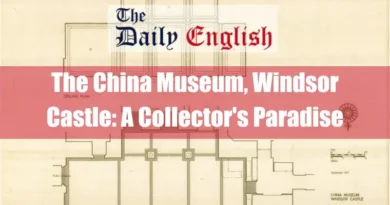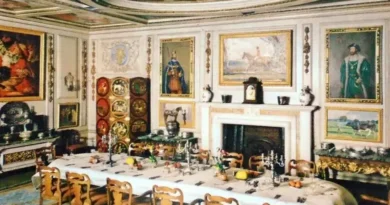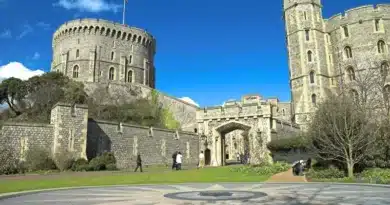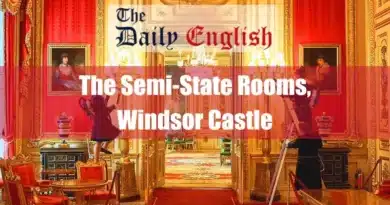The Crimson Drawing Room at Windsor Castle
Key Takeaways
| Key Takeaway | Description |
|---|---|
| A Royal Gem | The Crimson Drawing Room is a stunning semi-state room at Windsor Castle, known for its rich history, opulent design, and continued royal use. |
| A Rococo Revival | Designed by Sir Jeffry Wyatville in the 1820s, the room reflects the ornate and playful style of the Rococo Revival. |
| Crimson Splendor | The room’s signature crimson damask silk, accented with gold, creates a luxurious and inviting atmosphere. |
| Royal Functions | The Crimson Drawing Room is used for private audiences, meetings with dignitaries, and intimate social gatherings by the Royal Family. |
| Historical Significance | The room has witnessed centuries of royal history, from the Georgian era to the present day. |
| Resilience and Restoration | Despite a devastating fire in 1992, the room was meticulously restored to its former glory. |
| Public Access | While limited, visitors can sometimes access the room during guided tours of Windsor Castle. |
| A Glimpse into Royalty | The Crimson Drawing Room offers a unique glimpse into the private world of the British monarchy, showcasing the grandeur and elegance of royal life. |
I. Introduction: A Royal Jewel Within Historic Walls
Windsor Castle, a majestic fortress perched atop a hill overlooking the River Thames, has been a royal residence for over 900 years. Witnessing the ebb and flow of British history, its very stones whisper tales of kings and queens, battles won, and treaties signed. Within its imposing walls lies a treasure trove of grand apartments, each boasting unique character and historical significance. But nestled amongst these grand spaces rests a room known for its intimate charm and regal elegance – The Crimson Drawing Room.
The name itself sparks curiosity. Crimson, a bold and luxurious colour, hints at a room far from ordinary. Indeed, the Crimson Drawing Room is more than just a meeting space; it’s a vibrant tapestry woven from history, artistic expression, and ongoing royal use. This semi-state room, a favourite of the current Queen, offers a glimpse into the private lives of the British monarchs while serving as a stunning example of 19th-century interior design.
Interestingly, the room’s vibrant crimson hue isn’t its only claim to fame. Legend has it that a ghost, perhaps a former resident, occasionally roams the corridors near the Crimson Drawing Room, its presence felt as a sudden drop in temperature or a fleeting scent of lavender. Whether true or not, the story adds a touch of mystery to this captivating space.
Despite the spectral whispers, the Crimson Drawing Room’s true allure lies in its rich history, exquisite design, and enduring role in the British Royal Family’s life. In the following sections, we will delve into the fascinating narrative of this remarkable room, exploring its origins, architectural details, and significance as a cherished space within the hallowed halls of Windsor Castle.
II. History of the Crimson Drawing Room: A Tale of Transformation and Resilience

A. From Medieval Walls to Rococo Revival: Birth of the Crimson Drawing Room (1824-1828)
The story of the Crimson Drawing Room begins not with its construction but with a grand vision of transformation. Following the reign of King George III (1760-1820), his successor, King George IV (1820-1830), embarked on an ambitious project to revitalize the ageing royal apartments at Windsor Castle.
Dissatisfied with the outdated State Apartments on the north side, George IV commissioned the architect Sir Jeffry Wyatville (1766-1840) to create a new suite of private apartments on the east and south sides of the Upper Ward. Wyatville, a prominent architect known for his expertise in the Gothic Revival style, surprised many with his approach to the new apartments. Instead of adhering to the prevailing Gothic trend, he opted for a luxurious and playful reinterpretation of the Rococo style, a mid-18th-century artistic movement known for its ornate flourishes and asymmetrical designs.
B. A Room Reborn: Inspiration from Carlton House (1826)
The specific location for the Crimson Drawing Room held historical significance within the castle walls. Previously, it had been part of a larger suite of apartments occupied by Queen Charlotte (1744-1818), wife of George III, and her daughters. Wyatville’s design incorporated elements from these older apartments. Still, it drew inspiration from a specific space within another royal residence – Carlton House. Carlton House, a London palace favoured by George IV before his ascension to the throne, boasted a room known as the Crimson Drawing Room. This namesake room, famed for its opulent décor and use of crimson silk, likely served as a model for Wyatville’s creation at Windsor.
C. Crimson Glory: Design Choices and Decorative Elegance (1826-1828)
Working closely with furniture makers Morel and Seddon, Wyatville meticulously crafted the design of the Crimson Drawing Room. The room’s rectangular layout offered a sense of spaciousness, accentuated by large windows overlooking the East Terrace Garden and offering breathtaking views of the Berkshire countryside. The ceiling, a testament to the Rococo influence, showcased intricate plasterwork with a central medallion and decorative friezes. Walls were adorned with crimson silk damask, a rich fabric that lent the room its signature name. Complementing the crimson were accents of gold in the elaborate window treatments, picture frames, and furniture embellishments.
D. Evolution Through Time: Furnishings and Artistic Additions (1828-Present)
The décor of the Crimson Drawing Room has evolved over time, reflecting subsequent monarchs’ changing tastes and preferences. Queen Victoria (1837-1901) is believed to have introduced several items with sentimental value, while Queen Mary (1867-1953) is credited with adding the impressive central chandelier, a magnificent example of French craftsmanship that survived the devastating fire of 1992 (more on that later).
While the origin of the initial furnishings remains unclear, the room’s decoration has undoubtedly been shaped by the personal touches of various monarchs. Artwork displayed within the room has also seen changes, with portraits of various members of the Royal Family adorning the walls throughout history.
E. A Phoenix from the Ashes: The 1992 Fire and Restoration Efforts
In November 1992, a catastrophic fire broke out at Windsor Castle, causing extensive damage to several staterooms, including the Crimson Drawing Room. The flames destroyed much of the room’s original silk damask, furniture, and artwork. However, a remarkable restoration effort began in the aftermath of the tragedy. Expert artisans painstakingly recreated the room’s intricate details, sourcing new crimson silk from the same supplier that had provided the fabric in the 1820s. Lost furniture pieces were meticulously reproduced, and artworks were restored or replaced. By 1997, the Crimson Drawing Room had been reborn, once again a masterpiece of 19th-century design and a testament to the enduring spirit of Windsor Castle.
III. Architectural Details and Design: Unveiling the Crimson Jewel

The Crimson Drawing Room at Windsor Castle is more than just a name; it is a captivating space where history whispers through its architectural details and design choices. Let’s embark on a journey to explore the room’s intricate layout, its stylistic influences, and the symphony of colours and textures that create its unique ambience.
A. A Room of Proportion and Light: Layout and Architectural Features
The Crimson Drawing Room boasts a rectangular layout, measuring approximately 25 feet in length and 18 feet in width. This relatively spacious design creates a sense of grandeur, further accentuated by the room’s impressive height. Large, arched windows line two of the walls, allowing natural light to flood the space and offering picturesque views of the East Terrace Garden and the sprawling landscape beyond. The remaining walls are punctuated by doorways framed with elaborately carved mouldings, creating a sense of balance and symmetry.
B. A Rococo Revival: Architectural Style and Influences
Sir Jeffry Wyatville, a prominent architect recognized for his Gothic Revival work, surprised many with his design for the Crimson Drawing Room. Here, he showcased his versatility by employing the playful and ornate spirit of the Rococo Revival. This mid-18th-century artistic movement is characterized by its use of curved lines, asymmetrical designs, and an abundance of decorative flourishes.
Evidence of this style can be seen in the intricately detailed plasterwork adorning the ceiling. The central medallion, surrounded by flowing floral motifs and geometric patterns, creates a focal point that draws the eye upwards. Furthermore, the ornate picture frames adorning the walls, with their delicate curves and intricate carvings, further echo the Rococo aesthetic.
C. A Symphony of Crimson and Gold: Color Scheme and Textiles
The name “Crimson Drawing Room” leaves little doubt about the room’s dominant colour. Crimson damask silk, a rich and luxurious fabric, covers the walls, creating a sense of warmth and grandeur. This striking hue is not meant to overwhelm, however. Wyatville masterfully balanced the boldness of crimson with accents of gold. Golden embellishments can be found throughout the room, adorning the picture frames, the intricate details on furniture legs, and the elaborate window treatments. These gold accents add a touch of luxury and elegance, creating a harmonious interplay with the crimson backdrop.
D. Woven into History: The Significance of Textiles
The textiles used in the Crimson Drawing Room are not merely decorative elements but threads woven into the fabric of history. The original crimson damask silk, tragically lost in the 1992 fire, was remarkably recreated using the same supplier that provided the fabric in the 1820s. This commitment to historical accuracy ensures that the room retains its original character and reflects the design choices of its creators.
Beyond the walls, luxurious textiles likely adorn some of the furniture, adding layers of texture and craftsmanship to the space. Further research into historical descriptions or inventories of the room’s furnishings could provide more details about the specific use of silk fabrics and tapestries.
E. A Feast for the Eyes: Furniture and Art
The furniture within the Crimson Drawing Room reflects its royal occupants’ refined taste and social status. Upholstered chairs and sofas, likely crafted from mahogany or other fine woods, are adorned with intricate carvings and opulent fabrics, complementing the room’s Rococo Revival style. Consoles and side tables may feature delicate marquetry, providing surfaces for displaying cherished objects or floral arrangements.
While the specifics of the original furniture remain unclear, historical descriptions or inventories of the room’s furnishings could offer more details about the materials, styles, and any potential pieces brought from Carlton House.
F. Portraits of Power and Lineage: Artwork
The walls of the Crimson Drawing Room serve as a canvas for the room’s vibrant colours and a gallery for showcasing esteemed members of the Royal Family. Throughout history, portraits of monarchs, consorts, and other prominent figures have adorned the space. These artworks, whether grand oil paintings or more intimate miniatures, contribute to the historical significance of the room, linking the Crimson Drawing Room to the broader narrative of the British monarchy.
IV. The Crimson Drawing Room in Use: A Stage for Private Gatherings

The Crimson Drawing Room at Windsor Castle transcends its role as a beautifully designed space; it serves a specific purpose within the royal household. This section will delve into the room’s function as a semi-state room, exploring the types of events held there, its significance in the daily life of the Royal Family, and the limited glimpses the public has of this captivating space.
A. A Space for Intimacy: The Purpose of a Semi-State Room
Unlike the grand State Rooms at Windsor Castle, used for large-scale ceremonies or official receptions, the Crimson Drawing Room is a “semi-state room.” This designation signifies a space reserved for smaller, more intimate gatherings. The room’s cosy yet elegant atmosphere makes it ideal for private audiences granted by the monarch, meetings with dignitaries or foreign officials, and smaller social events involving close friends and family members.
While specific details of events held in the room are understandably private, historical accounts or examples of how other semi-state rooms are used within the royal household can provide a clearer picture of the Crimson Drawing Room’s typical functions. For instance, the room might be used for:
- Private audiences: The Queen may use the room to grant audiences to individuals or delegations in a setting that fosters conversation and intimacy.
- Meetings with dignitaries: Visiting heads of state or other important figures might be received in the Crimson Drawing Room for smaller-scale discussions on official matters.
- Social gatherings: The room’s inviting atmosphere may be used for intimate social gatherings with close friends or family members.
B. A Stage for Memorable Moments: Events Held in the Crimson Drawing Room
The specific details of events in the Crimson Drawing Room are understandably private. However, based on its designation as a semi-state room, we can imagine the types of gatherings it might host. Private audiences: The Queen may use the room to grant audiences to individuals or delegations in a setting that fosters conversation and intimacy. Meetings with dignitaries: Visiting heads of state or other important figures might be received in the Crimson Drawing Room for smaller-scale discussions on official matters. Social gatherings: The room’s inviting atmosphere may be used for intimate social gatherings with close friends or family members. Perhaps the Queen enjoys afternoon tea with loved ones in this comfortable and elegant space.

C. Anecdotes and Intrigue: Historical Events Associated with the Room
While specifics remain confidential, historical records offer glimpses into past uses of the Crimson Drawing Room. Queen Victoria (1837-1901) reportedly used the room for private meetings and audiences. Beyond documented uses, the room’s versatility as a space for formal and informal gatherings is evident.
Further research into historical accounts or official records might reveal more details about specific events held in the room throughout history.
D. A Royal Sanctuary: Significance in the Daily Life of the Royal Family
Beyond its role in official engagements, the Crimson Drawing Room likely holds personal significance for the Royal Family. Imagine it as a haven within the vastness of Windsor Castle. The Queen can escape the public eye in this space and unwind in a familiar and comfortable setting. It’s a place to enjoy quiet tea, read a book, or reflect in a setting steeped in history and beauty.
E. A Glimpse Behind the Curtain: Public Access to the Room
Like most private areas within Windsor Castle, public access to the Crimson Drawing Room is limited. However, the Royal Collection occasionally publicly opens specific State Rooms for tours during designated times. Unfortunately, information about which rooms are included can change, and the Crimson Drawing Room may not always be part of these tours.
Despite limited physical access, there are still ways to experience the beauty of the Crimson Drawing Room. The Royal Collection Trust website often features official photographs of the room, offering a detailed look at its décor and grandeur. Additionally, some online resources may showcase the Crimson Drawing Room, providing valuable insights.
Virtual tours of Windsor Castle are currently unavailable. However, if they are reinstated, they might offer a glimpse of the State Apartments, potentially including a distant view of the Crimson Drawing Room. It’s best to check the official website of the Royal Collection Trust for updates on virtual tours and their content.
V. Conclusion: A Timeless Jewel in the Royal Crown
The Crimson Drawing Room at Windsor Castle is a testament to British royalty’s enduring legacy. More than just a beautifully designed space, it’s a room steeped in history, a stage for intimate gatherings, and a cherished haven within the castle walls. Its exquisite Rococo Revival design, with its vibrant crimson hues and intricate details, reflects the refined tastes of its creators. The room’s resilience through fire and restoration speaks to its enduring significance.
As the Queen continues to utilize the Crimson Drawing Room for private events, it remains a vital part of the ongoing narrative of the British Royal Family. This captivating, abundant and intimate space offers a glimpse into the lives of monarchs, past and present. The Crimson Drawing Room is a vibrant jewel within the royal crown, a symbol of history, elegance, and the enduring legacy of Windsor Castle.
VI. FAQ
Who commissioned the Crimson Drawing Room, and when?
King George IV (1820-1830) commissioned the Crimson Drawing Room as part of a larger project to revitalize the royal apartments at Windsor Castle. Construction likely began around 1824 and was completed by 1828.
What space did the Crimson Drawing Room replace?
Previously, the location of the Crimson Drawing Room was part of a suite of apartments occupied by Queen Charlotte (1744-1818) and her daughters. Sir Jeffry Wyatville, the architect, incorporated elements from these older apartments into his design for the new room.
What was the inspiration for the Crimson Drawing Room’s name?
The name likely drew inspiration from a specific room within another royal residence – Carlton House. Carlton House, a London palace favoured by George IV before his ascension to the throne, boasted a room known as the Crimson Drawing Room, famed for its opulent décor and use of crimson silk.
How has the furnishing of the Crimson Drawing Room evolved?
The initial furnishing likely consisted of pieces transferred from Carlton House. However, the room’s décor has evolved. Queen Victoria (1837-1901) is believed to have introduced sentimental items, while Queen Mary (1867-1953) added the impressive central chandelier. Artwork has also seen changes, with portraits of various members of the Royal Family adorning the walls throughout history.
What was the impact of the 1992 fire on the Crimson Drawing Room?
A catastrophic fire in November 1992 caused extensive damage to the Crimson Drawing Room, destroying much of the original silk damask, furniture, and artworks. However, a remarkable restoration effort followed, with experts meticulously recreating the room’s details and lost furniture pieces.
How did the Crimson Drawing Room survive the 1992 fire?
While the exact reasons why the Crimson Drawing Room survived the 1992 fire remain undisclosed, several factors likely played a role:
Fire Location: The location of the fire within Windsor Castle might have spared the room from the most intense flames.
Firefighter Efforts: The valiant efforts of firefighters likely played a crucial role in containing the blaze and preventing it from completely engulfing the room.
Removal of Furnishings: It’s possible that some of the room’s furnishings or artworks were removed before the fire’s full impact, minimizing the damage within the space itself.
What evidence remains of the Crimson Drawing Room’s original design?
While the 1992 fire caused significant damage, the restoration project aimed for historical accuracy. The original crimson damask silk was recreated from the same supplier, and lost furniture pieces were meticulously reproduced. This ensures the room retains its original character and reflects the design choices of its creators.
What is the historical significance of the Crimson Drawing Room?
The Crimson Drawing Room has served as a principal reception room within Windsor Castle, hosting numerous royal events and gatherings. Its opulent design reflects the grandeur of the Regency period, showcasing exquisite craftsmanship and luxurious furnishings.
Who was responsible for the interior design of the Crimson Drawing Room?
The furnishings of the Crimson Drawing Room were primarily supplied by Morel & Seddon, the principal suppliers to King George IV. Their work exemplifies the lavish style preferred during the Regency era.
How does the Crimson Drawing Room compare to other drawing rooms in Windsor Castle?
Alongside the White and Green Drawing Rooms, the Crimson Drawing Room features carved, gilded wooden panels illustrating weapons and the spoils of war, many with Masonic meanings. These rooms collectively include a total of 62 such trophies, showcasing remarkable vitality, precision, and three-dimensional quality.
Are there any notable artworks associated with the Crimson Drawing Room?
The Crimson Drawing Room is the setting of the painting “The Family of Queen Victoria,” which was painted in 1887 by Laurits Regner Tuxen to commemorate the gathering of Queen Victoria’s family.
How can visitors experience the Crimson Drawing Room today?
The Crimson Drawing Room is part of the Semi-State Rooms at Windsor Castle, which are usually open to visitors from autumn to spring each year. Visitors can explore the room’s opulent interior and enjoy its spectacular views across the Berkshire countryside.
What are some unique architectural features of the Crimson Drawing Room?
The room is adorned with restored Gobelins French tapestries and features a set of carved, gilded wooden panels illustrating weapons and the spoils of war, many with Masonic meanings. These elements contribute to its status as one of the greatest set-pieces of Regency decoration.
How has the Crimson Drawing Room been used during the festive season?
During the Christmas season, the Crimson Drawing Room is traditionally decorated with festive ornaments. In recent years, a Nordmann Fir tree has been placed in the room, aligning with King Charles’s sustainability efforts, as the tree is replanted after the holidays.










Comments are closed.